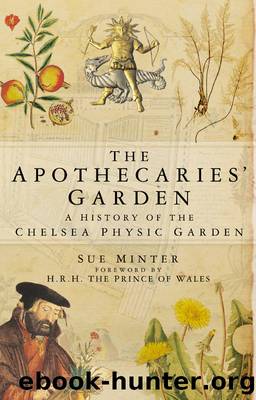The Apothecaries' Garden by Sue Minter

Author:Sue Minter [Karin Cadwell, Cindy Turner-Maffei]
Language: eng
Format: epub
Publisher: The History Press
Published: 2013-01-15T00:00:00+00:00
5
1899â1970: A NEW BENEFACTOR
AND A NEW ROLE
The last days of the Society of Apothecaries at the Chelsea Physic Garden had been marked by a declining interest in the study of plants in relation to medicine and increasing financial stringency within the Society. Casting these issues aside a new benefactor stepped in to rescue the Garden, at the instigation of the Charity Commissioners and, in so doing, completely transformed its role.1
The City Parochial Foundation was a new charity, founded in 1891, for applying funds to âthe poorer classes of the Metropolisâ. Before the entry of the state into the financing of public education beyond the age of fourteen under the Education Act of 1944, it was common for secondary education to be supported by charity. The City Parochial Foundation gave considerable support to technical education, especially polytechnics, in its early years. A Treasury enquiry had identified a need for educational provision to students of botany from the Royal College of Science and from London polytechnics. This could be provided at the Garden. And it was this charitable educational role which the Foundation decided to accept as within its objects as its first long-term commitment as a charity. The objects of the Garden under its new scheme were that:
The Charity and its endowments shall be administered exclusively for the promotion of the study of Botany, with special reference to the requirements of
(a) General Education
(b) Scientific instruction and research in Botany including Vegetable Physiology, and
(c) Instruction in Technical Pharmacology as far as the culture of medicinal plants is concerned From the Charity Commission scheme of 1899
Provided the costs did not exceed about 2 per cent of the gross income of the Central Fund of the Foundation, the support to the Garden was solid. But it meant that the Garden was now more focused on the provision of plants for general research and teaching, rather than the growing of plants for identification by apothecaries and medical students in training. Though some pharmacological training continued, in fact many decades of the Gardenâs history in the twentieth century mirror the development of agricultural research, particularly the focus on the physiology and diseases of crop plants including cereals such as rye and root crops. Plant and animal physiology, along with traditional plant breeding, were the agricultural sciences of the first half of the twentieth century in the same way as the more controversial sciences of genetic modification tended to dominate in the later decades.
The Committee of Management set about its new charge with characteristic energy, with a staff appointment and a major rebuilding programme. William Hales was appointed as Curator and Head Gardener rolled into one at the recommendation of Sir William Thistelton-Dyer, Director of Kew. The requirement was for âan expert in the cultivation of plants, with sufficient scientific knowledge to enable him to satisfy the requirements of the various lectures and classesâ. This âworking curatorshipâ was a great success for the Garden and Hales became one of its more distinguished Curators during twenty-eight years of service.
Download
This site does not store any files on its server. We only index and link to content provided by other sites. Please contact the content providers to delete copyright contents if any and email us, we'll remove relevant links or contents immediately.
| Great Britain | General |
| Bath | Devon |
| Gloucestershire | London |
| Yorkshire |
Room 212 by Kate Stewart(4729)
The Crown by Robert Lacey(4567)
Endurance: Shackleton's Incredible Voyage by Alfred Lansing(4491)
The Iron Duke by The Iron Duke(4113)
The Rape of Nanking by Iris Chang(4016)
Killing England by Bill O'Reilly(3896)
Joan of Arc by Mary Gordon(3778)
Say Nothing by Patrick Radden Keefe(3720)
I'll Give You the Sun by Jandy Nelson(3267)
Shadow of Night by Deborah Harkness(3169)
Hitler's Monsters by Eric Kurlander(3152)
Mary, Queen of Scots, and the Murder of Lord Darnley by Alison Weir(3056)
Blood and Sand by Alex Von Tunzelmann(3052)
Darkest Hour by Anthony McCarten(3016)
Margaret Thatcher: The Autobiography by Thatcher Margaret(2969)
Eleanor & Park by Rainbow Rowell(2938)
Red Famine: Stalin's War on Ukraine by Anne Applebaum(2814)
Book of Life by Deborah Harkness(2714)
The One Memory of Flora Banks by Emily Barr(2682)
